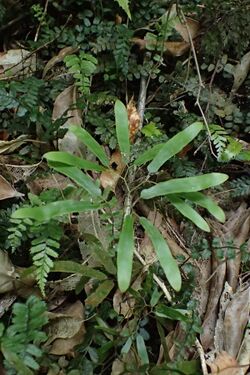Biology:Lygodium articulatum
| Lygodium articulatum | |
|---|---|

| |
| Scientific classification | |
| Kingdom: | Plantae |
| Clade: | Tracheophytes |
| Division: | Polypodiophyta |
| Class: | Polypodiopsida |
| Order: | Schizaeales |
| Family: | Lygodiaceae |
| Genus: | Lygodium |
| Species: | L. articulatum
|
| Binomial name | |
| Lygodium articulatum A.Rich.
| |
Lygodium articulatum, commonly referred to as mangemange or Bushman's mattress, is a fern endemic to the North Island forests of New Zealand. Mangemange is an endemic species and is unique compared to other ferns in the area due to the vine–like curtain it creates in the canopy.[1] Although the majority of the plant is found in the canopy of the surrounding forest, the roots and stem of mangemange form on the ground, meaning it cannot be classified as an epiphyte.
Description
Lygodium articulatum roots extend laterally from the stem (rhizome) of the plant. The rhizomes of mangemange are hairy and long-creeping, giving rise to widely spaced fronds.[2] Fronds grow alternately from the stem and form dichotomous costae that twist and climb until they find nearby branches or trees. Once the plant has the support of a branch, stipes and pinnae form. Mangemange will form either sterile vegetative pinnae (10 cm) or fertile pinnae (1 cm). Sterile pinnae are flat and smooth while fertile pinnae are wrinkled and fan shaped, terminating in spore structures that release a yellow spore-dust when ripe.[3]
Lygodium articulatum will often grow rapidly 3 metres (9.8 ft) high in a tree, where it may become a wall or curtain of leaves and twiggy vines. It is often difficult to navigate through due to the strength of the rhizomes.[1] This behavior is common to its genus Lygodium, and has led to several members of the genus' widespread success. A common example is the behavior of Lygodium japonicum, which similarly forms dense vertical mats, that are currently highly invasive and damagin in Northern Florida.[4]
Taxonomy
Lygodium articulatum is considered by modern systematists to be a member of a basally divergent clade within the Lygodium genus.[5]While pre-modern phylogenetic studies that relied on morphology had considered it to be a highly derived member of the genus,[6] modern molecular phylogenetic studies have found it to be a member of a basally divergent clade alongside its temperate North American sister, Lygodium palmatum.[7]
Distribution and habitat
Mangemange is mainly found on the North Island of New Zealand, specifically in the Northland, Auckland, Volcanic Plateau, Gisborne and Taranaki regions. It grows from sea level to 950 metres (3,120 ft) in elevation.
Since it is a climbing fern that uses neighboring structures to grow, its habitat is mainly based on the distribution of other species such as the manuka and kanuka scrub, and in kauri, podocarp and broadleaved forest.[3]
Native use
The term "Bushman's mattress" comes from the springiness of the vines and stems of L. articulatum. The Māori would make beds by coiling the springy vines and putting them in sacks, then stuff the sacks with available soft flora. Natives also used the tough wiry stems for things like fishhooks, rope, thatching, and eel traps. The leaves and fronds were infused with water and drunk to cure stomach aches and pains. When dried out, the leaves give off a pleasant aroma and were at times even used as a type of diaper.[8][unreliable source?]
References
- ↑ 1.0 1.1 "Lygodium articulatum". Oratia Native Plant Nursery. Oratia Native Plant Nursery. 2015. http://www.oratianatives.co.nz/catalogue_extras.php?article_id=204. Retrieved 7 December 2017.
- ↑ Croft, Jim (November 1999). "An Introduction to the Structure of Ferns and their Allies". Australian National Herbarium. http://www.anbg.gov.au/fern/structure.html#epiphyte. Retrieved 7 December 2017.
- ↑ 3.0 3.1 "Lygodium articulatum". Flora of New Zealand. http://www.nzflora.info/factsheet/taxon/Lygodium-articulatum.html. Retrieved 7 December 2017.
- ↑ "| Center for Aquatic and Invasive Plants | University of Florida, IFAS". https://plants.ifas.ufl.edu/plant-directory/lygodium-japonicum/.
- ↑ Madeira, Paul T.; Pemberton, Robert W.; Center, Ted D. (2008-06-01). "A molecular phylogeny of the genus Lygodium (Schizaeaceae) with special reference to the biological control and host range testing of Lygodium microphyllum". Biological Control 45 (3): 308–318. doi:10.1016/j.biocontrol.2008.02.004. ISSN 1049-9644. https://www.sciencedirect.com/science/article/pii/S1049964408000388.
- ↑ Garrison Hanks, Judith (1998). A monographic study of Lygodium Swartz.. University of Michigan.
- ↑ Madeira, Paul T.; Pemberton, Robert W.; Center, Ted D. (2008-06-01). "A molecular phylogeny of the genus Lygodium (Schizaeaceae) with special reference to the biological control and host range testing of Lygodium microphyllum". Biological Control 45 (3): 308–318. doi:10.1016/j.biocontrol.2008.02.004. ISSN 1049-9644. https://www.sciencedirect.com/science/article/pii/S1049964408000388.
- ↑ Vennell, Robert (11 April 2017). "Mangemange – Lygodium articulatum". The Meaning of Trees. http://meaningoftrees.com/2017/04/11/mangemange-lygodium-articulatum/. Retrieved 7 December 2017.
Wikidata ☰ Q17043114 entry
 |

